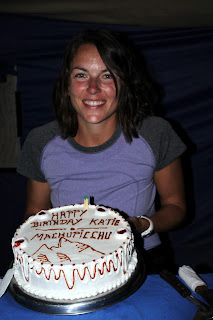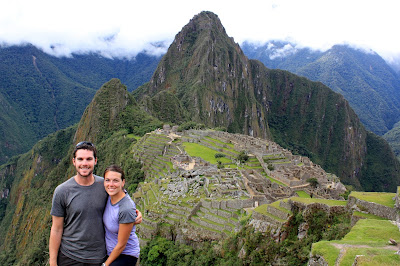“…From the city of Cuzco there are two roads or royal highways which are two thousand miles long; one goes along the plains and the other along the mountaintops…”
- Garcilaso de la Vega
Over a year ago, we began making plans to summit Machu Picchu on my 30th birthday. This was probably the single activity that we spent the most time researching and organizing. It’s also what we built our entire South American itinerary around. We had been looking forward to this moment for a long time.
The Inca Trail hike is a 4-day, 27-mile trek just beyond the Sacred Valley, culminating with The Lost City of the Inca’s – Machu Picchu. The fastest recorded time to complete the Inca Trail was set by a porter in 3 hours, 45 minutes. That's 11 minutes better than my fastest marathon time.
3 days before my birthday, we began the trek with 12 fellow hikers. Everyone in our group was either American or Irish and all around our age, with the exception of one retired couple from Alaska. We had a great time with these guys and felt so lucky that we got paired up with the group that we did.
3 days before my birthday, we began the trek with 12 fellow hikers. Everyone in our group was either American or Irish and all around our age, with the exception of one retired couple from Alaska. We had a great time with these guys and felt so lucky that we got paired up with the group that we did.
Aside from the hike itself, one of the most interesting and memorable aspects of the trek was the support crew needed to pull it off. Every day, there are only 500 people allowed on each section of the Inca Trail. 200 are the hikers…300 are the crew. For our group of 14 hikers we had: 15 porters, 2 chefs, 1 coordinator, and 2 guides. Our team of 20 gave us a 5-star camping experience that completely spoiled us and ruined our expectations of “camping” forever.
The porters are tiny little men who come from neighboring communities. At the beginning of the trial there is a weigh station, and under new regulations, each porter is only allowed to carry 25 kilos (55 pounds).
We slept in tents at campsites, but these were not your normal campsites with picnic tables. Our porters literally transported a mini-city for us every day – tents, bags, chairs, cooking equipment and food. The porter with the most balance was given the task of carrying the eggs. 2 of the porters were solely dedicated to carrying propane tanks.
Carrying the weight on their backs, the porters would run the trail so that they could get to our lunch spot and have everything set up by the time we arrived.
After we ate, our guides would give us about 15 minutes to digest the food before we started hiking again. That’s when the porters would break down the city, throw everything on their backs, and run the trail to catch up and surpass us so that they could have dinner and the campsite setup by the time we got there.
We always had bowls of fresh water waiting for us to wash our hands.
This level of service went on for 4 days. They worked extremely hard, and on top of it all, they were really nice people.
We also ate better during our 4 days in the wilderness than about 75% of our meals so far in South America. We feasted on more vegetables in 4 days than we’ve had in 3 months combined. Each lunch and dinner consisted of at least 5 courses. We had food that shouldn’t even be spoken in the same sentence as the word camping…fried chicken, ceviche, popcorn, pizza, vegetable stir fry, spaghetti with meatballs, fried rice, quinoa porridge, avocado salad, corn on the cob, fried trout, stuffed peppers, pancakes and chocolate pudding just to name a few. Every morning we had a personal wake-up call at our tent with warm coca tea.
Our guides, Oscar and Aldo, were patient and so incredibly nice. If anyone were to have trouble getting over a mountain pass, these two guys were ready at any moment to literally carry them over.
Day 1
We hiked 9 miles in about 5.5 hours. This was a relatively flat day with a tough uphill section at the end. We were surprised how many different kinds of wildflowers lined the trail in all sorts of colors – red, orange, white, blue, purple, pink, yellow.
There wasn’t anything too unusual about this day…we spent most of it getting settled in with our group, the porters and this new sophisticated style of camping. Day 1 is also when I got a small bug bite that ended up infecting my ankle by Day 4.
Day 2
We hiked 10 miles over 8.5 hours. With 2 mountain passes topping out at 13,780 feet, this was by far our hardest day of hiking. To make things more challenging, it rained almost the entire day. We couldn’t believe how quickly the weather would change every 10 minutes. It went something like this: sunny, foggy, rainy, foggy, rainy, sunny, rainy, foggy, rainy. I have never in my life done a hike where I had to change my clothes so often. It made it hard to get into a groove, and we were more than happy to arrive at our campsite that evening.
As the porters were putting the final touches on the dinner table, a double rainbow appeared over some Inca ruins on the hillside overlooking our campsite.
As the porters were putting the final touches on the dinner table, a double rainbow appeared over some Inca ruins on the hillside overlooking our campsite.
It turned out to be a beautiful night with a sky full of stars.
Day 3
Because of the elevation of our campsite at 11,810 feet, this was our coldest morning. We were completely bundled up in every article of clothing that we brought with us. This was also a short and easy day of hiking – 5.5 miles over 4.5 hours. We had great weather and the views were spectacular. This is also where the trail turned into more of a jungle, and we saw also sorts of wild orchids. We got to our campsite early enough to take naps and even shower!
At dinner that night, I was surprised with a huge birthday cake and lots of singing hikers. We honestly would have believed our guides if they said a porter had carried the cake all that way…that’s how good they are. But it turns out that the cooks made this fancy cake on-site without even an oven.
Day 4
We were woken up at 3:15am to get on the trail as early as possible. By 6:30am we arrived at the Sun Gate, which is the point where you get to see Machu Picchu for the first time. From high up on the hill, our first impression was that Machu Picchu is really small.
We spent another 45
minutes getting closer and closer until we reached Machu Picchu at 7,870 feet. I can’t even tell you how relieved we felt that the
weather was clear. We had been worrying about rain and fog for months.
Machu Picchu was officially discovered by a Yale professor named Hiram Bingham in 1911, when an 11-year old local boy showed him the way. It became really famous in 1913 when National Geographic dedicated an entire edition to the Inca city. Nobody knows exactly what it was used for, but most likely it was a city for the noble class. Archeologists believe that we can’t even see half of Machu Picchu, which is in the form of underground foundation and drainage systems.
The unfortunate news is that Machu Picchu is sinking. Even pictures of Hiram Bingham in 1911 show huge cracks in the walls.
One of the hikers in our group did the Inca Trail 37 years ago when people were not required to go with a guide and you could camp in the ruins along the trail if you wanted. It was insightful to see his pictures and hear his stories of how regulated Machu Picchu has become. This, combined with the sinking problem, really makes us wonder about how much access the public will have to Machu Picchu 30 years from now. Will we even be able to walk among the buildings or will we just be able to view it from a platform 50 feet away?
We spent 8 hours walking around the site and doing some side hikes to the Inca Bridge and up Huayna Picchu – the large mountain that gives Machu Picchu its classic backdrop. Everyone told us about the views from Huayna Picchu, but no one mentioned how amazing the hike itself is. It took us 40 minutes to get to the top via a system of extremely narrow and steep steps and steel cables.
From the top it was easy to see how Machu Picchu was built in the shape of a condor. From this picture the condor is upside down with the head and neck top and center.
In normal fashion, the weather was changing constantly and we got to see Machu Picchu from all sides in the sun, rain and mysteriously shifting fog.
I think we walked enough steps to last us the rest of the year. After 4 days of hiking and 8 hours of scampering around Machu Picchu, we were beat. It couldn't have been a better birthday. I wish I could have talked with my family, but life is lived for days like these and I wouldn’t have traded it for anything.
























Good post.
ReplyDeleteYour blog really cool and interesting. Thank you very much for sharing this blog us.
inca trail to machu picchu
This comment has been removed by the author.
ReplyDelete